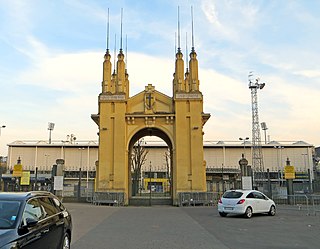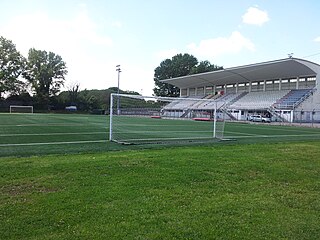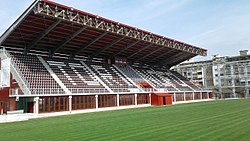
The Stadio delle Alpi was a football and athletics stadium in Turin, Italy, and was the home of both Juventus Football Club and Torino Football Club between 1990 and 2006. In English, the name meant "Stadium of the Alps", a reference to the nearby Alps mountain range. The stadium was demolished in 2009 and both football clubs moved to the rebuilt Stadio Olimpico. A new stadium for Juventus, the Juventus Stadium, was constructed on the site of the former delle Alpi and opened in 2011.

The Superga air disaster occurred on 4 May 1949, when a Fiat G.212 of Avio Linee Italiane, carrying the entire Torino football team, crashed into the retaining wall at the back of the Basilica of Superga, which stands on a hill on the outskirts of Turin. All thirty-one people on the flight died.

Stadio Atleti Azzurri d'Italia, known for sponsorship reasons as the Gewiss Stadium since July 2019 and as Stadio di Bergamo in UEFA competitions, is a stadium in Bergamo, Italy. It is the home of Serie A club Atalanta and has a capacity of 21,000 seats. The field is 120 m (130 yd) long and 70 m (77 yd) wide. Atalanta has owned the stadium since 2017, having purchased it from the comune.

The Grande Torino was the historic Italian football team of Torino Football Club in the 1940s, five-time champions of Italy, whose players were the backbone of the Italy national team and died on 4 May 1949 in the plane crash known as the Superga air disaster. The Filadelfia Stadium was built by Enrico Marone Cinzano, the grandfather of Carlo Rivetti.

Stadio Ennio Tardini, commonly referred to as just Il Tardini, is a football stadium in Parma, Italy, located near the centre of Parma, between the town centre and the city walls. It is the home of Parma Calcio 1913. The stadium was built in 1923 and was named after one of Parma's former presidents, Ennio Tardini. The stadium is the nineteenth largest football stadium in Italy and the second largest in Emilia–Romagna with a capacity of 22,352 spectators. The stadium is the sixth oldest Italian football ground still in use.

Stadio Angelo Massimino is a multi-use stadium in Catania, Italy. It is used mostly for football matches and the home of Calcio Catania. The stadium was built in 1935 by architect Raffaele Leone on behalf of the company owned by Antonio Ferro and holds 23,266 people. It was renamed in 2002 after former Catania chairman Angelo Massimino (1927–1996).

The Stadio Olimpico Grande Torino is a multi-purpose stadium located in Turin, Italy. It is the home ground of Serie A club Torino Football Club. The stadium is located in Piazzale Grande Torino, in the district of Santa Rita, in the south-central area of the city. The stadium is currently rated by UEFA as a Category 4 stadium, the highest ranking possible.

Valerio Bacigalupo was an Italian footballer who played as a goalkeeper.

Stadio Briamasco, previously known as Stadium, is a multi-use stadium in Trento, Italy. Owned by the city, it is primarily used for football and is the home ground of A.C. Trento 1921 S.S.D. The stadium is equipped with a six-lane athletics track and is also used as an archery and cycling venue.

Turin is a city and an important business and cultural centre in Northern Italy. It is the capital city of Piedmont and of the Metropolitan City of Turin, and was the first Italian capital from 1861 to 1865. The city is mainly on the western bank of the Po River, below its Susa Valley, and is surrounded by the western Alpine arch and Superga Hill. The population of the city proper is 847,287 while the population of the urban area is estimated by Eurostat to be 1.7 million inhabitants. The Turin metropolitan area is estimated by the OECD to have a population of 2.2 million.

Torino Football Club, commonly referred to as Torino or simply Toro, is an Italian professional football club based in Turin, Piedmont. They currently play in Serie A.

The Stadio di Corso Marsiglia was a multisports stadium located in Turin (Italy). It was designed by architect Amedeo Lavini.

The 1937–38 Coppa Italia was the 3rd edition of the tournament under the organization of the Higher Directory. The competition was won by Juventus.
The following is a timeline of the history of the city of Turin, Piedmont, Italy.
Sauro Tomà was an Italian footballer who played as a full-back.
Sports in Turin have a rich heritage as the home to two historically significant football teams: Juventus F.C. and Torino F.C.. Juventus has the larger fan base, especially in southern Italy and worldwide, while Torino enjoys a more localised support. The two clubs contest the oldest derby in Italy, the Derby della Mole or the Turin derby.

The following outline is provided as an overview of and topical guide to Turin:

Piero Operto was an Italian football player, who played as a defender.
The 1970 Women's World Cup was an association football tournament organised by the Federation of Independent European Female Football (FIEFF) in Italy in July 1970. It featured women's teams from seven countries and is the first known tournament to be named as a women's football World Cup.

The Stadio Gino Alfonso Sada is a multi-purpose stadium in Monza, Italy, and the home of Fiammamonza. Mostly used for football matches, the stadium was built in 1945 and has a capacity of 2,000.





















